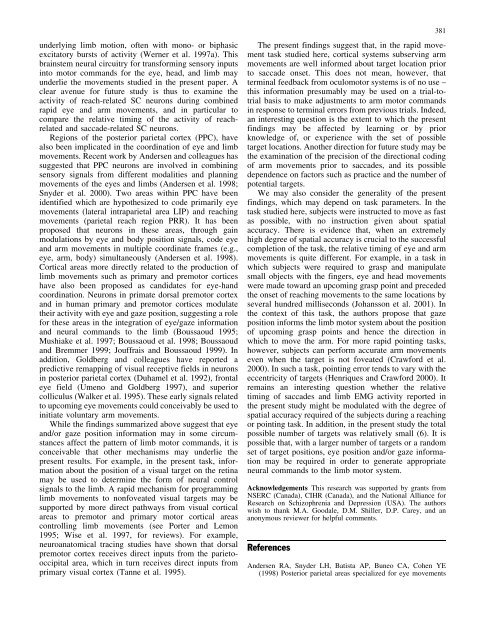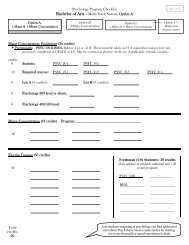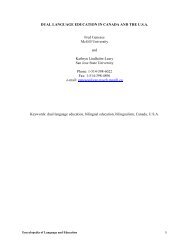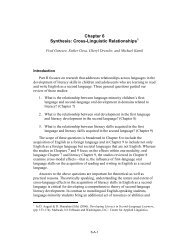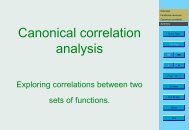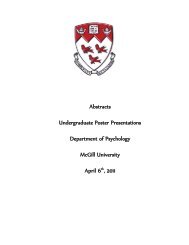Hand-eye coordination for rapid pointing movements - ResearchGate
Hand-eye coordination for rapid pointing movements - ResearchGate
Hand-eye coordination for rapid pointing movements - ResearchGate
You also want an ePaper? Increase the reach of your titles
YUMPU automatically turns print PDFs into web optimized ePapers that Google loves.
underlying limb motion, often with mono- or biphasic<br />
excitatory bursts of activity (Werner et al. 1997a). This<br />
brainstem neural circuitry <strong>for</strong> trans<strong>for</strong>ming sensory inputs<br />
into motor commands <strong>for</strong> the <strong>eye</strong>, head, and limb may<br />
underlie the <strong>movements</strong> studied in the present paper. A<br />
clear avenue <strong>for</strong> future study is thus to examine the<br />
activity of reach-related SC neurons during combined<br />
<strong>rapid</strong> <strong>eye</strong> and arm <strong>movements</strong>, and in particular to<br />
compare the relative timing of the activity of reachrelated<br />
and saccade-related SC neurons.<br />
Regions of the posterior parietal cortex (PPC), have<br />
also been implicated in the <strong>coordination</strong> of <strong>eye</strong> and limb<br />
<strong>movements</strong>. Recent work by Andersen and colleagues has<br />
suggested that PPC neurons are involved in combining<br />
sensory signals from different modalities and planning<br />
<strong>movements</strong> of the <strong>eye</strong>s and limbs (Andersen et al. 1998;<br />
Snyder et al. 2000). Two areas within PPC have been<br />
identified which are hypothesized to code primarily <strong>eye</strong><br />
<strong>movements</strong> (lateral intraparietal area LIP) and reaching<br />
<strong>movements</strong> (parietal reach region PRR). It has been<br />
proposed that neurons in these areas, through gain<br />
modulations by <strong>eye</strong> and body position signals, code <strong>eye</strong><br />
and arm <strong>movements</strong> in multiple coordinate frames (e.g.,<br />
<strong>eye</strong>, arm, body) simultaneously (Andersen et al. 1998).<br />
Cortical areas more directly related to the production of<br />
limb <strong>movements</strong> such as primary and premotor cortices<br />
have also been proposed as candidates <strong>for</strong> <strong>eye</strong>-hand<br />
<strong>coordination</strong>. Neurons in primate dorsal premotor cortex<br />
and in human primary and premotor cortices modulate<br />
their activity with <strong>eye</strong> and gaze position, suggesting a role<br />
<strong>for</strong> these areas in the integration of <strong>eye</strong>/gaze in<strong>for</strong>mation<br />
and neural commands to the limb (Boussaoud 1995;<br />
Mushiake et al. 1997; Boussaoud et al. 1998; Boussaoud<br />
and Bremmer 1999; Jouffrais and Boussaoud 1999). In<br />
addition, Goldberg and colleagues have reported a<br />
predictive remapping of visual receptive fields in neurons<br />
in posterior parietal cortex (Duhamel et al. 1992), frontal<br />
<strong>eye</strong> field (Umeno and Goldberg 1997), and superior<br />
colliculus (Walker et al. 1995). These early signals related<br />
to upcoming <strong>eye</strong> <strong>movements</strong> could conceivably be used to<br />
initiate voluntary arm <strong>movements</strong>.<br />
While the findings summarized above suggest that <strong>eye</strong><br />
and/or gaze position in<strong>for</strong>mation may in some circumstances<br />
affect the pattern of limb motor commands, it is<br />
conceivable that other mechanisms may underlie the<br />
present results. For example, in the present task, in<strong>for</strong>mation<br />
about the position of a visual target on the retina<br />
may be used to determine the <strong>for</strong>m of neural control<br />
signals to the limb. A<strong>rapid</strong> mechanism <strong>for</strong> programming<br />
limb <strong>movements</strong> to nonfoveated visual targets may be<br />
supported by more direct pathways from visual cortical<br />
areas to premotor and primary motor cortical areas<br />
controlling limb <strong>movements</strong> (see Porter and Lemon<br />
1995; Wise et al. 1997, <strong>for</strong> reviews). For example,<br />
neuroanatomical tracing studies have shown that dorsal<br />
premotor cortex receives direct inputs from the parietooccipital<br />
area, which in turn receives direct inputs from<br />
primary visual cortex (Tanne et al. 1995).<br />
The present findings suggest that, in the <strong>rapid</strong> movement<br />
task studied here, cortical systems subserving arm<br />
<strong>movements</strong> are well in<strong>for</strong>med about target location prior<br />
to saccade onset. This does not mean, however, that<br />
terminal feedback from oculomotor systems is of no use –<br />
this in<strong>for</strong>mation presumably may be used on a trial-totrial<br />
basis to make adjustments to arm motor commands<br />
in response to terminal errors from previous trials. Indeed,<br />
an interesting question is the extent to which the present<br />
findings may be affected by learning or by prior<br />
knowledge of, or experience with the set of possible<br />
target locations. Another direction <strong>for</strong> future study may be<br />
the examination of the precision of the directional coding<br />
of arm <strong>movements</strong> prior to saccades, and its possible<br />
dependence on factors such as practice and the number of<br />
potential targets.<br />
We may also consider the generality of the present<br />
findings, which may depend on task parameters. In the<br />
task studied here, subjects were instructed to move as fast<br />
as possible, with no instruction given about spatial<br />
accuracy. There is evidence that, when an extremely<br />
high degree of spatial accuracy is crucial to the successful<br />
completion of the task, the relative timing of <strong>eye</strong> and arm<br />
<strong>movements</strong> is quite different. For example, in a task in<br />
which subjects were required to grasp and manipulate<br />
small objects with the fingers, <strong>eye</strong> and head <strong>movements</strong><br />
were made toward an upcoming grasp point and preceded<br />
the onset of reaching <strong>movements</strong> to the same locations by<br />
several hundred milliseconds (Johansson et al. 2001). In<br />
the context of this task, the authors propose that gaze<br />
position in<strong>for</strong>ms the limb motor system about the position<br />
of upcoming grasp points and hence the direction in<br />
which to move the arm. For more <strong>rapid</strong> <strong>pointing</strong> tasks,<br />
however, subjects can per<strong>for</strong>m accurate arm <strong>movements</strong><br />
even when the target is not foveated (Craw<strong>for</strong>d et al.<br />
2000). In such a task, <strong>pointing</strong> error tends to vary with the<br />
eccentricity of targets (Henriques and Craw<strong>for</strong>d 2000). It<br />
remains an interesting question whether the relative<br />
timing of saccades and limb EMG activity reported in<br />
the present study might be modulated with the degree of<br />
spatial accuracy required of the subjects during a reaching<br />
or <strong>pointing</strong> task. In addition, in the present study the total<br />
possible number of targets was relatively small (6). It is<br />
possible that, with a larger number of targets or a random<br />
set of target positions, <strong>eye</strong> position and/or gaze in<strong>for</strong>mation<br />
may be required in order to generate appropriate<br />
neural commands to the limb motor system.<br />
Acknowledgements This research was supported by grants from<br />
NSERC (Canada), CIHR (Canada), and the National Alliance <strong>for</strong><br />
Research on Schizophrenia and Depression (USA). The authors<br />
wish to thank M.A. Goodale, D.M. Shiller, D.P. Carey, and an<br />
anonymous reviewer <strong>for</strong> helpful comments.<br />
References<br />
381<br />
Andersen RA, Snyder LH, Batista AP, Buneo CA, Cohen YE<br />
(1998) Posterior parietal areas specialized <strong>for</strong> <strong>eye</strong> <strong>movements</strong>


